What is mmWave Radar? : Everything You Need to Know About FMCW
Why can human presence be detected? How does Parking Distance Control work? Radar has been adopted as a simple and practical solution in Artificial Intelligence. Pulse and FMCW are two main modulation techniques. However, when sensitivity and accuracy are put into consideration, FMCW is no doubt the preferred choice.
Now, let’s step into the world of FMCW radars.
What is FMCW Radar Sensor?
Frequency Modulated Continuous Wave (FMCW) Radar is a special type of radar sensor which radiates continuous transmission power like a simple continuous-wave radar.
Instead of using the time to measure distance (like TOF), FMCW technology emits a radar signal with a frequency that increases continuously to create a signal sweep. After being reflected by the process media surface, the signal’s echo will be picked up by the antenna. As the emitted signal is constantly varying in frequency, there is a slight difference between the frequencies of the echo and the emitted signals. This difference in frequency is directly proportional to the echo delay, thus allowing the accurate measurement of distances.
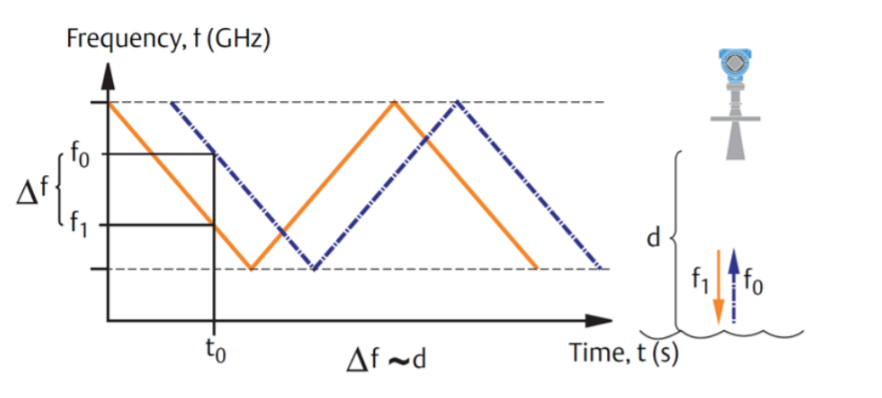
Level measurement scenario
Basic features of FMCW radar:
- Able to measure very small ranges to the target (the minimal measured range is comparable to the transmitted wavelength)
- Able to measure the target range and its relative velocity simultaneously
- Very high accuracy of range measurement
- Signal processing after mixing is performed at a low-frequency range, simplifying the realization of the processing circuits considerably
- Safety from the absence of the pulse radiation with a high peak power
How does FMCW Radar Sensor work?
Doppler principle is used to determine the object’s motion, speed, and even direction, given the complexity of the radar’s implementation. In the simple case of object detection, the radar transmits a 24 GHz waveform and reflects off an object that is in the sensor’s field of view. This reflected waveform is received by the radar transceiver. The received signal will have a frequency difference, referred to as the Doppler frequency. The Doppler frequency is then used to detect movement along with velocity. Depending on whether the 24GHz transceiver is fed with a Continuous Wave (CW) Doppler or Frequency Modulated CW (FMCW), other parameters of the object such as distance to the sensor can be derived. Given an additional antenna, the exact position or coordinates of the object in the field of view can be derived as well.
So, is radar the right technology for my application? The answer depends on the system requirements with respect to functionality and costs, and to fully answer this question, let us quickly review the performance capabilities of each of these sensors.
Technological Comparison between 24GHz sensor, Infrared, Ultrasonic, and Laser
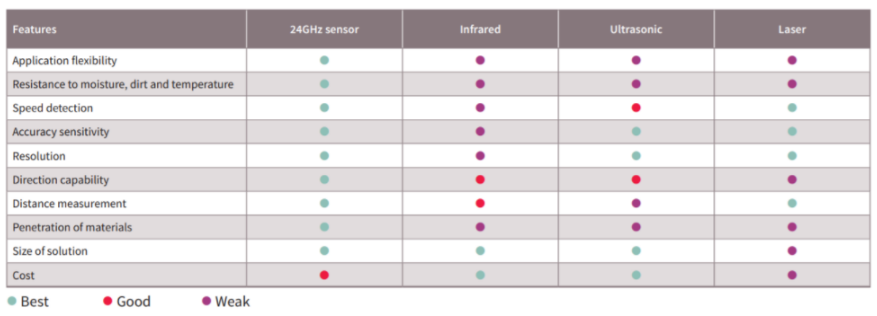
(pictures from Infineon)
The Advantages of FMCW Radar Sensor Compared to Other Radar Technologies
Based on different ranging principles, LADAR can be divided into TOF and FMCW.
Comparing them to each other can help us greatly understand TOF and FMCW. TOF (Time of Flight) measures distance by multiplying the amount of time a light pulse takes to travel between the target and the LiDAR by the speed of light. In contrast, FMCW emits and receives continuous laser beams, then uses the mixing detection technology to measure and convert the frequency difference between the sent and received signals. In short, TOF uses the time to measure distance while FMCW uses frequency to calculate distance.
The Advantages of FMCW to TOF are:
- Stronger light wave anti-interference ability
- Higher SNR (Signal-to-Noise Ratio)
- High-quality speed dimension data
- Compatible with OPA scanning architecture
- A higher degree of modulation
PIR is another type of traditional motion sensor.
Below are some advantages that radar possesses against some challenges of PIR:
| Use Case | Advantages of Radar | Challenges of PIR |
| Indoor lighting |  Increased detection range Increased detection range Energy-efficient by turning lights off automatically Energy-efficient by turning lights off automatically Can be discretely designed behind casing Can be discretely designed behind casing |  Limited range compared to radar Limited range compared to radar Limited coverage means more sensors required Limited coverage means more sensors required Unsightly design means PIR needs to be visible Unsightly design means PIR needs to be visible |
| Automatic door |  Detects direction of travel so only opens when necessary Detects direction of travel so only opens when necessary Keeps the building energy-efficient through the reduced door opening Keeps the building energy-efficient through the reduced door opening |  Only detects movement, irrespective of a person coming into the building Only detects movement, irrespective of a person coming into the building Can’t distinguish between people and animals Can’t distinguish between people and animals |
| Smart Street lighting |  Increased detection range Increased detection range Precision object identification Precision object identification 24GHz works independently of hot water 24GHz works independently of hot water |  Can be unreliable and impacted in harsh weather conditions Can be unreliable and impacted in harsh weather conditions Lack of object identification means false triggers Lack of object identification means false triggers No directional measurement No directional measurement |
| Intruder alarm |  Increased detection range Increased detection range Reduce false alarms Reduce false alarms  Detection sensitivity is adjustable Detection sensitivity is adjustable |  Unsightly design means PIR needs to be visible Unsightly design means PIR needs to be visible  Can be unreliable and impacted in harsh weather conditions Can be unreliable and impacted in harsh weather conditions Limited range/coverage means more sensors required Limited range/coverage means more sensors required |
24GHz mmWave Radar Sensor: Typical Application Scenarios in our Life
With the advancements in radar capabilities, it can help solve many problems in our daily lives. The sensors we currently offer are 24GHz mmWave Sensor for XIAO, 24GHz Human Static Presence Module Lite, 60GHz Human Resting Breathing and Heartbeat Module, 60GHz Fall Detection Pro Module, and 24GHz Respiratory Sleep Detection Module. Here is a comparison form that can showcase their differences. We will introduce more details about the hot-sale ones.
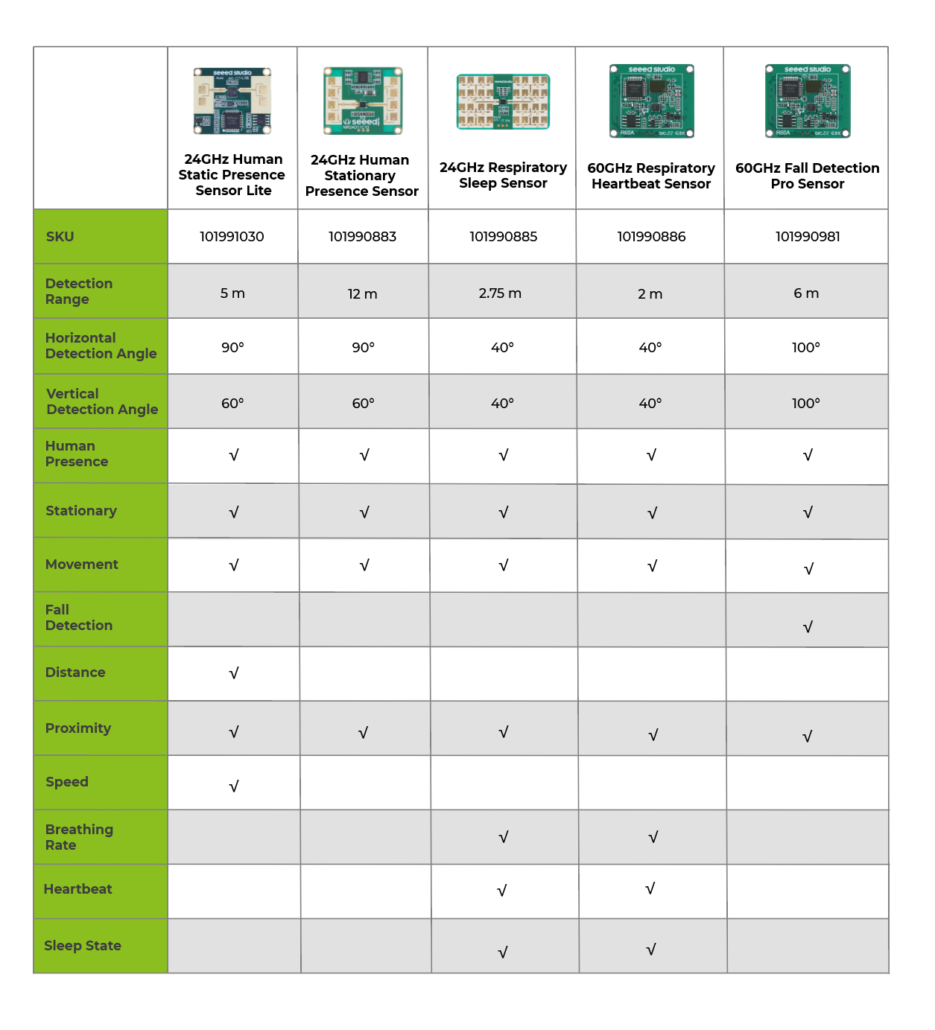
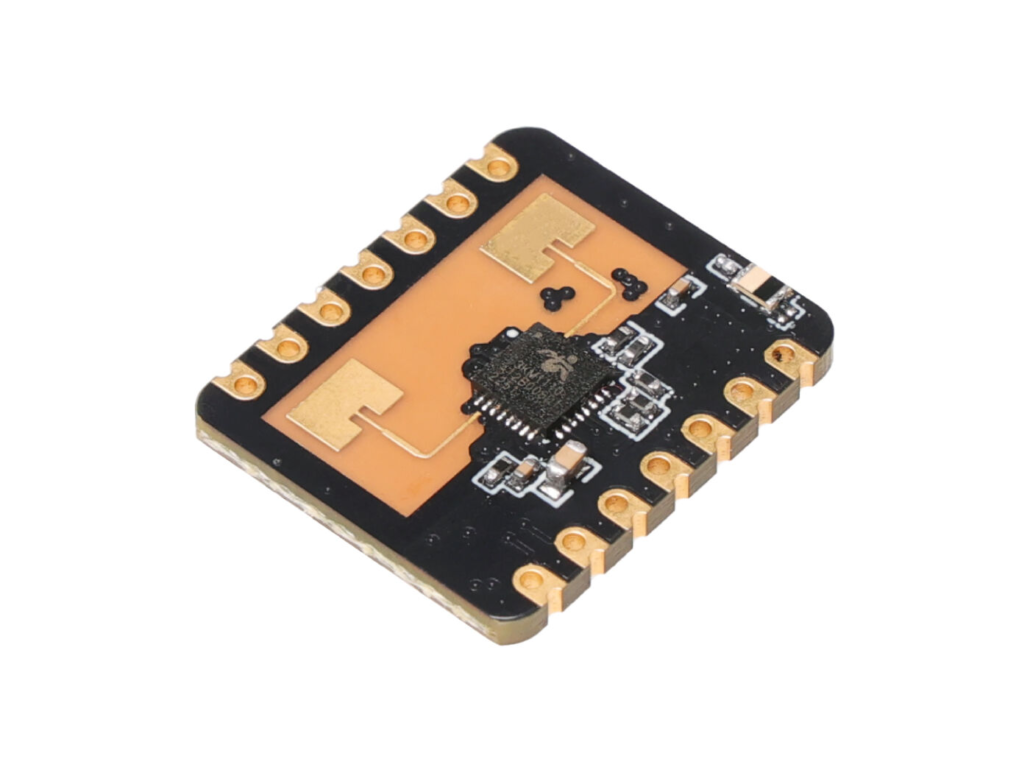
The 24GHz mmWave Sensor for XIAO – Human Static Presence is an extension board designed for the XIAO development platform. It serves as a highly advanced human body sensing module that utilizes FMCW (Frequency-Modulated Continuous Wave) technology to detect human targets within a designated space.
Powered by sophisticated radar signal processing and precise human body sensing algorithms, this module achieves exceptional sensitivity in detecting human presence, accurately identifying both moving and stationary states. It also provides auxiliary information such as target distance calculation. Primarily deployed in indoor environments, this product offers real-time detection of moving or micro-moving human bodies.
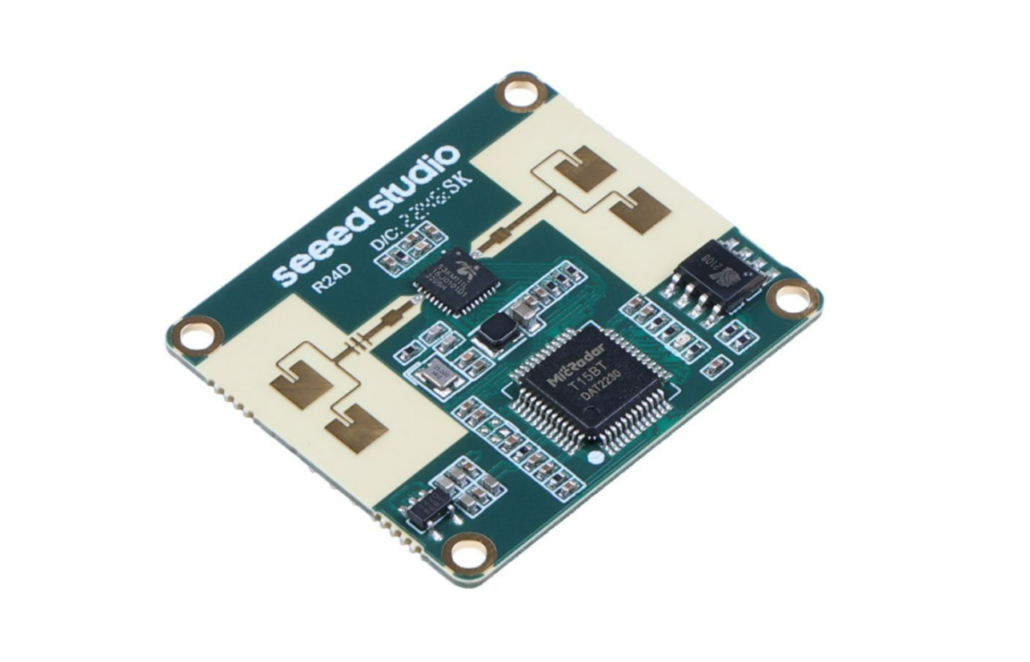
24GHz mmWave Sensor – Human Static Presence Module Lite is an antenna-integrated, high-sensitivity mmWave radar sensor that is based on the FMCW principle. It is user-friendly by providing visual debugging and configuration tools. It can flexibly adapt to various scenarios as multiple underlying parameters is configurable. With Arduino support, it is an easy-to-use and cost-effective choice for various human presence-detecting applications.
Key Features:
- Based on the FMCW principle: highly sensitive and immune to environmental interferences
- Visual debugging and configuration tools: straightforward and simple to use while keeping the data clearly presented
- More parameter modulation options: multiple configurable underlying parameter settings to meet the different needs in various scenarios
- Compatible with Arduino Library: adopts UART and provides Arduino library support
- Home Assistant Ready: wiki to walk you through how to integrate it with Home Assistant
It can help precisely detect whether there are people in a specific space and then trigger some necessary automation. Here are some scenarios we can explore deeper:
- Human body induction device: intelligent lighting devices that can switch on/off automatically based on whether there is a human there
- intelligent security alert system to identify intrusion for home security
- home appliances on/off control system: make economical use of electricity, gas, or other forms of energy
Medicare Sensor: Respiratory Sleep mmWave Radar Module $28.00
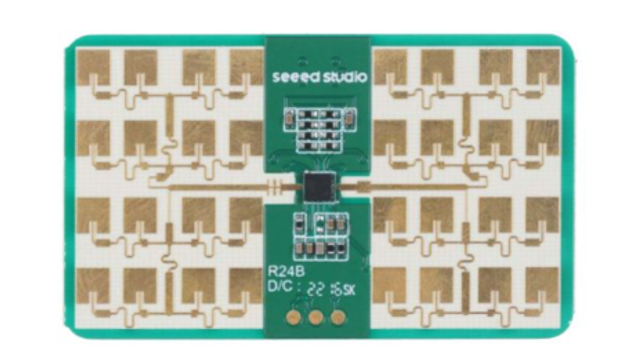
The MR24BSD1 24GHz radar module applies Doppler radar detection technology to implement human sleep quality monitoring, detecting body moving and stationary along with human breathing rate, providing a fully private and secure environment, independently from other noisy influences. It represents useful privacy-protected, secure sensor radar systems in smart home applications like sleep safety alarms, sleep respiratory detection, and movement monitoring.
Compared to the traditional PIR sensor, 24GHz mmWave sensors offer better performance in human activity detection for high sensitivity. mmWave sensors are quite useful in living rooms, hotels, or even in prisons that require monitoring all the time.
60GHz mmWave Radar Sensor: Typical Application Scenarios in our Life
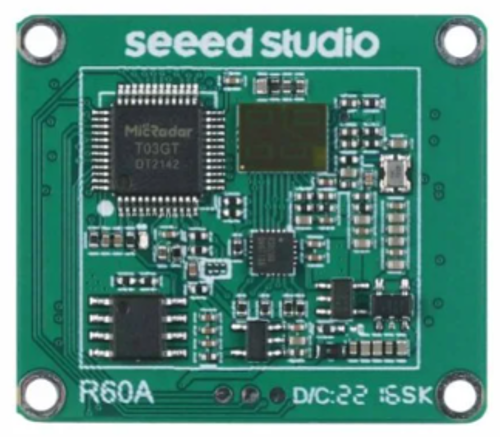
The MR60BHA1 60GHz radar module implements personal breathing rate and heart rate detection based on Frequency Modulation Continuous Wave(FMCW) detected theory, providing a fully private and secure environment. The unit ensures simultaneous signal output with high accuracy. It’s the ideal solution for high-accurate, self-regulation, privacy-protected, secure biotic radar systems in consumer electronics, healthcare as well as industrial applications.
60 GHz mmWave sensors will offer significantly better performance than 24 GHz sensors for high-accuracy and reliable object identification. Meanwhile, they gather rich point-cloud data as it is critical to maintaining high measurement accuracy for respiratory and heartbeat scenarios. As the radar works mainly on the basis of the respiratory heart rhythm causing undulating movements on the surface of the large muscles through 60 GHz mmWave, the undulation of the human chest and back will be more pronounced.
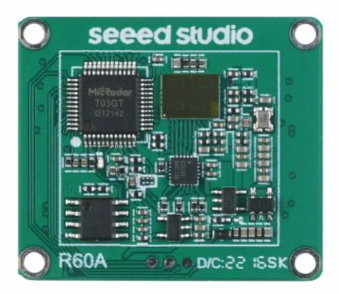
In comparison to 24 GHz mmWave fall detection radar sensors, 60 GHz sensors gather richer point-cloud data for greater sensitivity, and fewer errors to improve accuracy in a conceivable way. In particular, fine velocity resolution enables better tracking of lateral movements to allow more stable detection of moving objects. Hence, 60 GHz radar sensors offer as much as 2.5 times better velocity resolution performance than 24 GHz. Meanwhile, because the range resolution is heavily dependent on available bandwidth, 60 GHz mmWave fall detection radar sensors will offer significantly better performance than the 24 GHz ones in high-accuracy and reliable human activities identification, particularly fall detection. Compare to 1T1R(1 transmit 1 receive) as 24 GHz radar sensors, 60 GHz offers 1T3R, with FMCW theory, the mounting antenna on the module, showcasing the real professional.
The above sensors both support secondary developments. Their improvable factors such as small size, digital output, and inside algorithm allow them to be applied in various scenario applications using a universal UART communication interface through development boards like XIAO ESP32C3, XIAO nRF52840 Sense, and XIAO RP2040. We welcome you to join our Discord channel and share with us any interesting ideas or projects using them. Chat with our engineers, and you may receive some benefits!
Ready-to-use mmWave Sensor Kit
mmWave Human Detection Sensor Kit $26.99

Powered by Seeed Studio XIAO ESP32C3, it supports Wi-Fi/BLE connectivity and offers precise human detection via mmWave sensors. Seamlessly connect grove modules for added features. Achieve easy setup for Home Assistant within 1-2 minutes, coupled with convenient wireless Over-The-Air (OTA) updates. Enable extensive versatility with replaceable mmWave sensors. Ideal for customizing smart home automation, detecting intrusions, and monitoring the well-being of the elderly.
Check out the seamless set up process in the video:
Hi Guys, This is interesting for us. So far we use infrared for person tracking. As far as I know, RADAR can harm people when they are exposed to it for a longer time. We don’t want to grill our user’s brains, you know? I am not sure whether this is related to the frequency. What about your device? Any known potential health risks?
Thanks in advance and best regards
Peter Lemke, CEO
Adaptive Home Automation
Literally above your comment: “The output power is very low which ensures it is harmless to the human body even in prolonged exposure.”